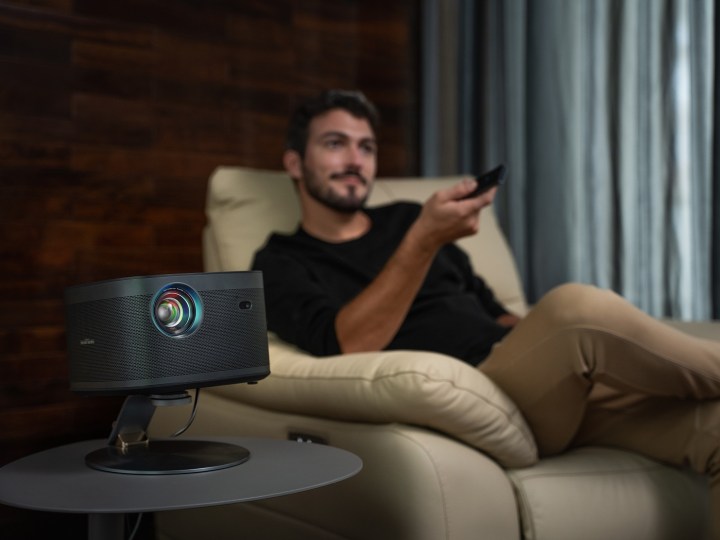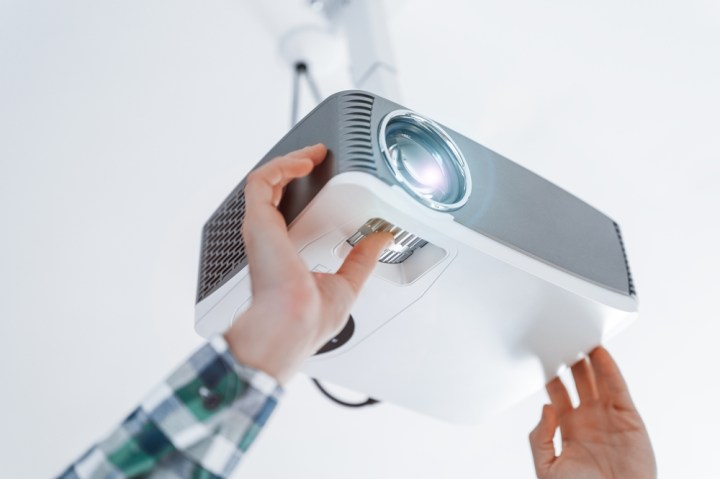A home projector is an excellent way to get a movie theater vibe in your home and an image much larger than what your HDTV can attain. Today’s projectors can achieve some amazing resolution, including 4K, and are a great solution for your home theater needs.
There’s just one trick: Projectors are a bit more complicated to set up than TVs, and may require a few extra steps. If you aren’t familiar with the process, our guide will walk you through what to tackle first, and what to know about making those key adjustments. Let's get started.
Find your optimal throw distance
When it comes to home theater projectors, your owner's manual is your best friend. In it you will find a ton of useful information about setup — most importantly, the throw distance for your projector. Throw distance is how far the projector should be from the screen for an optimal image. The farther away, the larger the image, but at a point, the image will start to gray out and pixelate.
Projectors generally outline the maximum image size that retains the maximum resolution, but you can go smaller than that, too. Projector images can be anywhere from a few hundred inches to the size of a traditional TV: Most are designed for a 1.13:1 throw ratio (that means for every 1.13-feet of distance from the screen, you get 1-foot of image width), but there’s some leeway. You can look up your model and choose an image size with this calculator to explore your options.
Using your manual as a guide, decide on how large you want your image to be, and calculate your throw distance. Many traditional projectors are designed around a throw distance of approximately 8 to 10 feet. Short throw projectors lessen that distance by a few feet, and ultra-short throw projectors are designed to be used within only a few inches.

Chart out space in your room
Now that you know your throw distance, it’s time to decide where to place your projector. Is your projector designed to be mounted to a base (where the lens is generally angled upward) or mounted to a ceiling (where the lens is angled downward)? Many can handle both with the correct placement.
Placing the projector on base on the floor makes it easy to use, and allows for much faster adjustments, connecting different input cables on the fly, and more. This configuration might be better for those who aren't using their projector as a permanent setup — perhaps bringing it out for movies or a big game. It also takes up room right in the center of your home theater setup and is more prone to being bumped into in this position.
A ceiling mount is a safer, more permanent option and keeps clear of the furniture. But it’s going to take some crawlspace or ceiling work and it’s designed to be permanent, so you can’t have any plans to move the projector around afterward.
Again, an ultra-short-throw projector is an alternative that can often fit in the same space as a TV stand or table, and avoids many of the pitfalls of other mounting options. But they can be expensive and generally can’t produce images as large as more traditional projectors, so you are giving up a couple of benefits.
Set up your screen
You know where and how you are going to mount your projector, and you’ve arranged your seating/tables so they won’t be in the way. Now it’s time to set up your screen. A screen isn’t absolutely required for your home projection, but we highly suggest it: It’s the only way to really get the resolution and color that projectors are capable of, and many home projectors are bundled with them.
Most screens are designed to be screwed to studs or drywall anchors in your wall or hung from installed hooks, and can usually be retracted when not in use (which means they can go over some windows). It’s important that you have enough height for the screen to fully match the projector image size you have chosen.
Make sure you use your level for this step and mark your wall for screw placements first, using the level to make sure the screen is perfectly horizontal.
Using a screen that comes on its own stand is a possibility, especially in a temporary setup, but it will take up extra room and can get jostled or moved out of place.

Find the right height and set up the stand or mount
Your projector will also have a recommended height (either from the floor or from the ceiling) that is should sit ar to attain the best image size. Your own manual can once again come in handy at this point, and now that the screen is set up, you can use it as a focal point if you want to turn on your projector and start getting things lined up. Don’t worry about getting things exactly right — that comes later. For now, finish the primary mounting.
Mounting from the ceiling is self-explanatory and ceiling mounts come with clear directions, although you will need to do some wiring work, and for that you might want to hire a professional. Mounting on the floor means making a few choices. There are many tripod mounts for projectors, but you might want something a little sturdy in your living room or movie zone: There are projector stands designed to be placed on existing tables, but you need to be cautious with this: An accidental bump or two can throw your projector out of whack and require tedious adjustments.
If you have no choice, you can find a table or shelf that’s near the suggested height, and make angle adjustments until your image is centered. Adjust the projector's angle carefully to avoid alignment issues — you want to avoid tilting it as much as possible for the best results.
Align your image with lens shifts
When you are ready, connect the projector and bring up its menu. The projector should have settings for specifying where you have placed it so it can start with the right image orientation. Settings may also have test patterns to use during setup, which are very handy. Otherwise, you may need to connect an input device like a streaming device or computer and bring up a high-res image during your adjustments.
On the projector, you should find options for a Lens Shift, or manually adjusting the projector lens both horizontally and vertically until it perfectly centers on your screen. Do this now.
Note: Do not mistake Keystone Correction with Lens Shift. Keystone Correction is a mode that adjusts the image itself to correct mistakes made with height and angle. It can interfere with image quality, and in a proper home setup it should not be necessary unless you are desperate for a quick fix.

Adjust your zoom and focus
Now that the projector is throwing the image in the exact right place, it’s time to make sure it’s in focus. Here, home projectors use zoom and focus controls that you will need to master. Find your zoom and focus controls (they are usually near the lens), and make adjustments until the image is crystal clear. Some projectors also allow you to set a ratio, in which case you should set it for the cinematic 16:9 ratio. There may be other modes, but you can experiment with these later as they won’t really impact your focus.
Once things are the right size and the resolution looks perfect, you may want to go through settings and adjust the brightness, contrast, sharpness, and so on. This isn’t completely necessary, but it’s a good time to nail these down and we have a guide that can help you do it.
Set up your audio
Projector audio, if included is … not great, especially if you’re trying to imitate a theater experience. This is why we advise pairing your home projector with a soundbar or a surround sound system connected to your input devices. If you have or want this additional speaker setup, now is the time to do it! We have a calibration guide to help out if you really want your audio to be on point.

Manage all your cables
With the projector set up, you probably have some cable work to do. Most home projectors Best new movies to stream on Netflix, Hulu, Amazon Prime, HBO, and moreuse HDMI, and can typically handle USB, too. You will need to decide where to run cables to keep them hidden, and make sure you purchase cables long enough to reach your devices. In a table-based setup, you may be able to put set-top boxes or other devices under the table, right next to the projector. For a ceiling mount, you’ll need to run cables through the ceiling and walls, or use a mount that has space for additional devices. Ultra short throw projectors need relatively little cable management, but you may want to make sure the cables are as low-profile as possible.
Now that your projector is all set up, all you need now is to find something good to watch, and we've got you covered for that, too.
Editors' Recommendations
- Best projector deals: Replace your TV with a big screen from $58
- The 10 best short throw and ultra short throw projectors
- Save $200 on this Epson 4K home theater projector at Best Buy
- Is the Apple Vision Pro the ultimate personal home theater?
- The 6 best portable projectors for movies, gaming, and more




